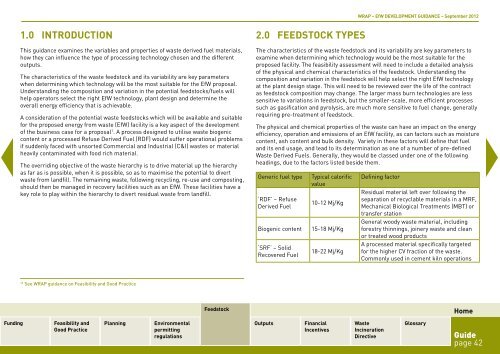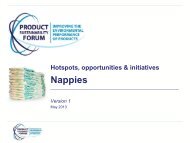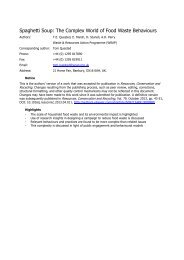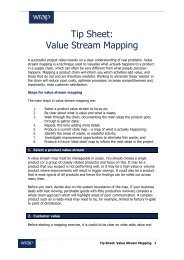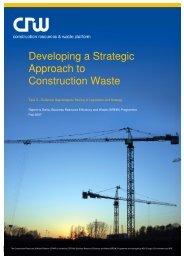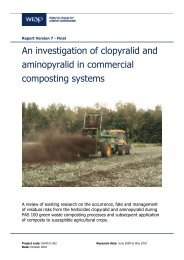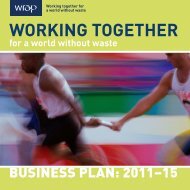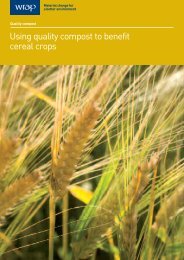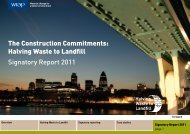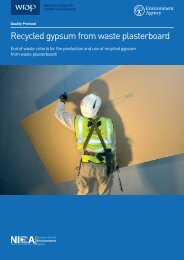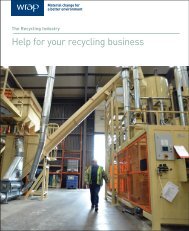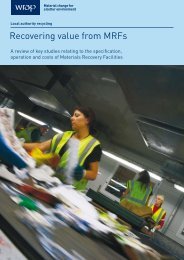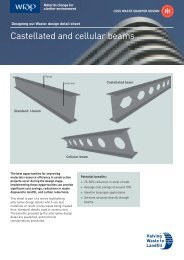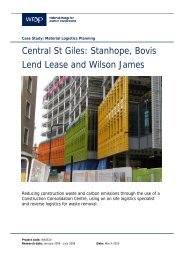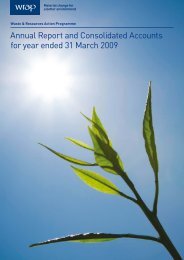EfW DEVELOPMENT GUIDANCE - Wrap
EfW DEVELOPMENT GUIDANCE - Wrap
EfW DEVELOPMENT GUIDANCE - Wrap
You also want an ePaper? Increase the reach of your titles
YUMPU automatically turns print PDFs into web optimized ePapers that Google loves.
WRAP – <strong>EfW</strong> <strong>DEVELOPMENT</strong> <strong>GUIDANCE</strong> – September 2012<br />
1.0 Introduction<br />
This guidance examines the variables and properties of waste derived fuel materials,<br />
how they can influence the type of processing technology chosen and the different<br />
outputs.<br />
The characteristics of the waste feedstock and its variability are key parameters<br />
when determining which technology will be the most suitable for the <strong>EfW</strong> proposal.<br />
Understanding the composition and variation in the potential feedstocks/fuels will<br />
help operators select the right <strong>EfW</strong> technology, plant design and determine the<br />
overall energy efficiency that is achievable.<br />
A consideration of the potential waste feedstocks which will be available and suitable<br />
for the proposed energy from waste (<strong>EfW</strong>) facility is a key aspect of the development<br />
of the business case for a proposal 1 . A process designed to utilise waste biogenic<br />
content or a processed Refuse Derived Fuel (RDF) would suffer operational problems<br />
if suddenly faced with unsorted Commercial and Industrial (C&I) wastes or material<br />
heavily contaminated with food rich material.<br />
The overriding objective of the waste hierarchy is to drive material up the hierarchy<br />
as far as is possible, when it is possible, so as to maximise the potential to divert<br />
waste from landfill. The remaining waste, following recycling, re-use and composting,<br />
should then be managed in recovery facilities such as an <strong>EfW</strong>. These facilities have a<br />
key role to play within the hierarchy to divert residual waste from landfill.<br />
2.0 Feedstock types<br />
The characteristics of the waste feedstock and its variability are key parameters to<br />
examine when determining which technology would be the most suitable for the<br />
proposed facility. The feasibility assessment will need to include a detailed analysis<br />
of the physical and chemical characteristics of the feedstock. Understanding the<br />
composition and variation in the feedstock will help select the right <strong>EfW</strong> technology<br />
at the plant design stage. This will need to be reviewed over the life of the contract<br />
as feedstock composition may change. The larger mass burn technologies are less<br />
sensitive to variations in feedstock, but the smaller-scale, more efficient processes<br />
such as gasification and pyrolysis, are much more sensitive to fuel change, generally<br />
requiring pre-treatment of feedstock.<br />
The physical and chemical properties of the waste can have an impact on the energy<br />
efficiency, operation and emissions of an <strong>EfW</strong> facility, as can factors such as moisture<br />
content, ash content and bulk density. Variety in these factors will define that fuel<br />
and its end usage, and lead to its determination as one of a number of pre-defined<br />
Waste Derived Fuels. Generally, they would be classed under one of the following<br />
headings, due to the factors listed beside them.<br />
Generic fuel type<br />
‘RDF’ – Refuse<br />
Derived Fuel<br />
Biogenic content<br />
‘SRF’ – Solid<br />
Recovered Fuel<br />
Typical calorific<br />
value<br />
10-12 Mj/Kg<br />
15-18 Mj/Kg<br />
18-22 Mj/Kg<br />
Defining factor<br />
Residual material left over following the<br />
separation of recyclable materials in a MRF,<br />
Mechanical Biological Treatments (MBT) or<br />
transfer station<br />
General woody waste material, including<br />
forestry thinnings, joinery waste and clean<br />
or treated wood products<br />
A processed material specifically targeted<br />
for the higher CV fraction of the waste.<br />
Commonly used in cement kiln operations<br />
10<br />
See WRAP guidance on Feasibility and Good Practice<br />
Feedstock<br />
Home<br />
Funding<br />
Feasibility and<br />
Good Practice<br />
Planning<br />
Environmental<br />
permitting<br />
regulations<br />
Outputs<br />
Financial<br />
Incentives<br />
Waste<br />
Incineration<br />
Directive<br />
Glossary<br />
Guide<br />
page 42


